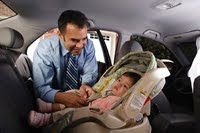How can injuries to children in motor vehicles be prevented?

- Child safety seats reduce the risk of death in passenger cars by 71% for infants, and by 54% for toddlers ages 1 to 4 years.
- There is strong evidence that child safety seat laws, safety seat distribution and education programs, community-wide education and enforcement campaigns, and incentive-plus-education programs are effective in increasing child safety seat use.
- The National Highway Traffic Safety Administration recommends booster seats for children until they are at least 8 years of age or 4'9" tall.
- According to researchers at the Children's Hospital of Philadelphia, for children 4 to 7 years, booster seats reduce injury risk by 59% compared to seat belts alone.
- All children ages 12 years and younger should ride in the back seat. Adults should avoid placing children in front of airbags. Putting children in the back seat eliminates the injury risk of deployed front passenger-side airbags and places children in the safest part of the vehicle in the event of a crash.
- Overall, for children less than 16 years, riding in the back seat is associated with a 40% reduction in the risk of serious injury. To learn more about effective interventions to increase child safety seat use, visit CDC's Motor Vehicle Occupant Safety page.

No comments:
Post a Comment